Blank L., Tarquin A. Engineering Economy (McGraw-Hill Series in Industrial Engineering and Management)
Подождите немного. Документ загружается.

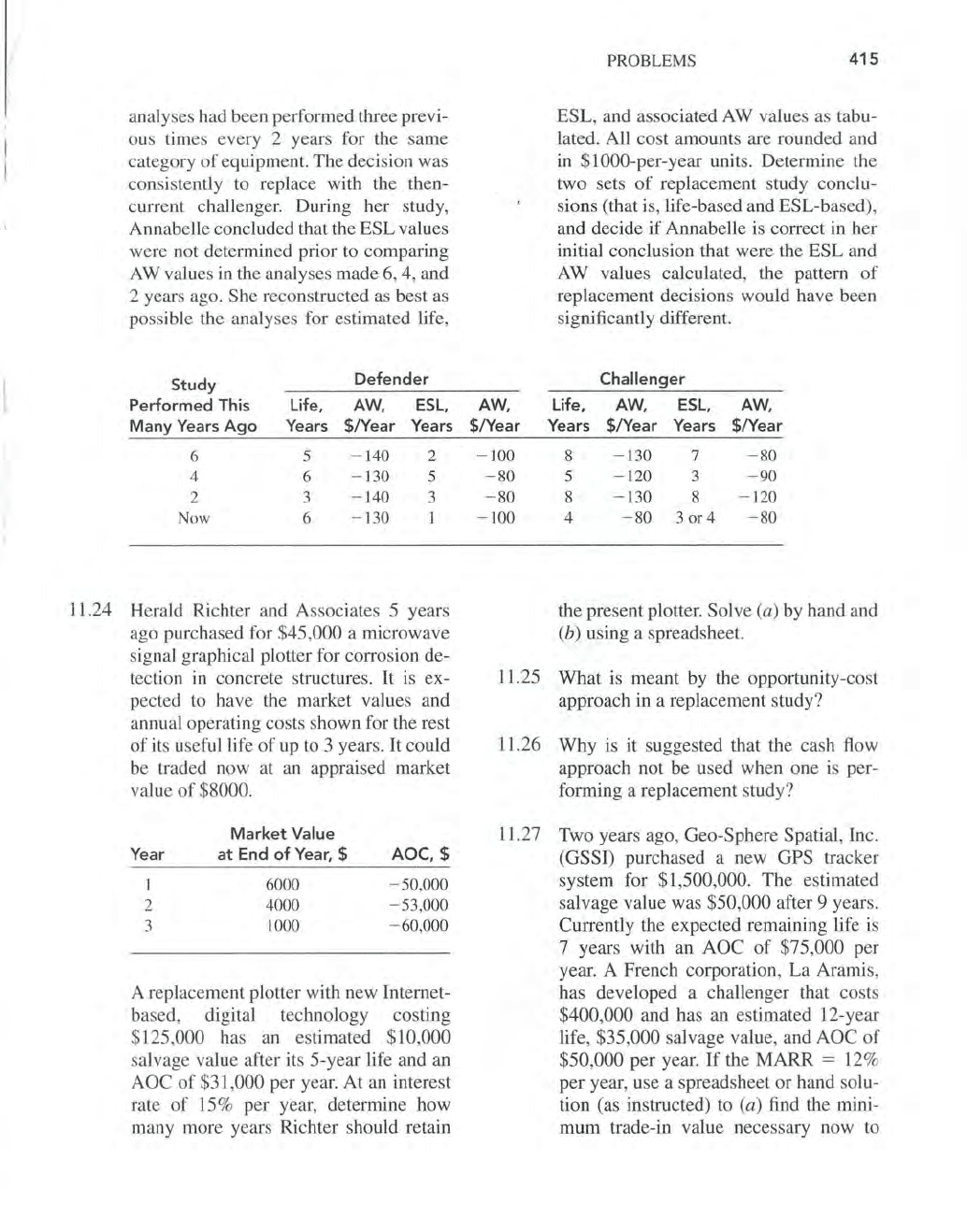
analyses had been performed three previ-
ous times every 2 years for the same
category
of
equipment. The decision was
consistently to replace with the then-
current challenger. During her study,
Annabelle concluded that the ESL values
were not determined prior to comparing
AW
values
in
the analyses made 6, 4, and
2 years ago. She reconstructed as best
as
possible the analyses for estimated life,
Study
Defender
Performed
This Life,
AW,
ESL,
Many Years
Ago
Years $lYear Years
6 5
- 140
2
4
6
-130
5
2 3
-140
3
Now
6
-130
11.24 Herald Richter and Associates 5 years
ago purchased for
$45,000 a microwave
signal graphical plotter for corrosion de-
tection
in
concrete structures. It
is
ex-
pected
to
have the market values and
annual operating costs shown for the rest
of
its useful life
of
up
to
3 years. It could
be traded now at
an
appraised market
value
of
$8000.
Market
Value
Year
at
End
of
Year, $
AOC,$
6000
- 50,000
2 4000 - 53,000
3
1000
-60,000
A replacement plotter with new Internet-
based, digital technology costing
$125,000 has
an
estimated $10,000
salvage value after its 5-year life and an
AOC
of
$31 ,000 per year. At
an
interest
rate
of
15%
per year, determine how
many more years Richter should retain
AW,
$lYear
-100
-80
-80
-100
PROBLEMS
415
ESL, and associated A W values
as
tabu-
lated. All cost amounts are rounded and
in $1000-per-year units. Determine the
two sets
of
replacement study conclu-
sions (that is, life-based and ESL-based),
and decide
if
Annabelle
is
correct in her
initial conclusion that were the ESL and
A W values calculated, the pattern
of
replacement decisions would have been
significantly different.
Challenger
Life,
AW,
ESL,
AW,
Years
$lYear
Years
$lYear
8
-130
7
-
80
5
-120
3
-90
8
-130
8
-
120
4
- 80
30r4
-80
the present plotter. Solve (a) by hand and
(b) using a spreadsheet.
11.25 What is meant by the opportunity-cost
approach in a replacement study?
11
.26 Why is it suggested that the cash flow
approach not be used when one is per-
forming a replacement study?
11.27 Two years ago, Geo-Sphere Spatial, Inc.
(GSSI) purchased a new
GPS tracker
system for
$1,500,000. The estimated
salvage value was
$50,000 after 9 years.
Currently the expected remaining life is
7 years with an
AOC
of
$75,000 per
year. A French corporation, La Aramis,
has developed a challenger that costs
$400,000 and has an estimated 12-year
life,
$35,000 salvage value, and AOC
of
$50,000 per year.
If
the MARR = 12%
per year, use a spreadsheet or hand solu-
tion (as instructed) to
(a) find the mini-
mum trade-in value necessary now
to
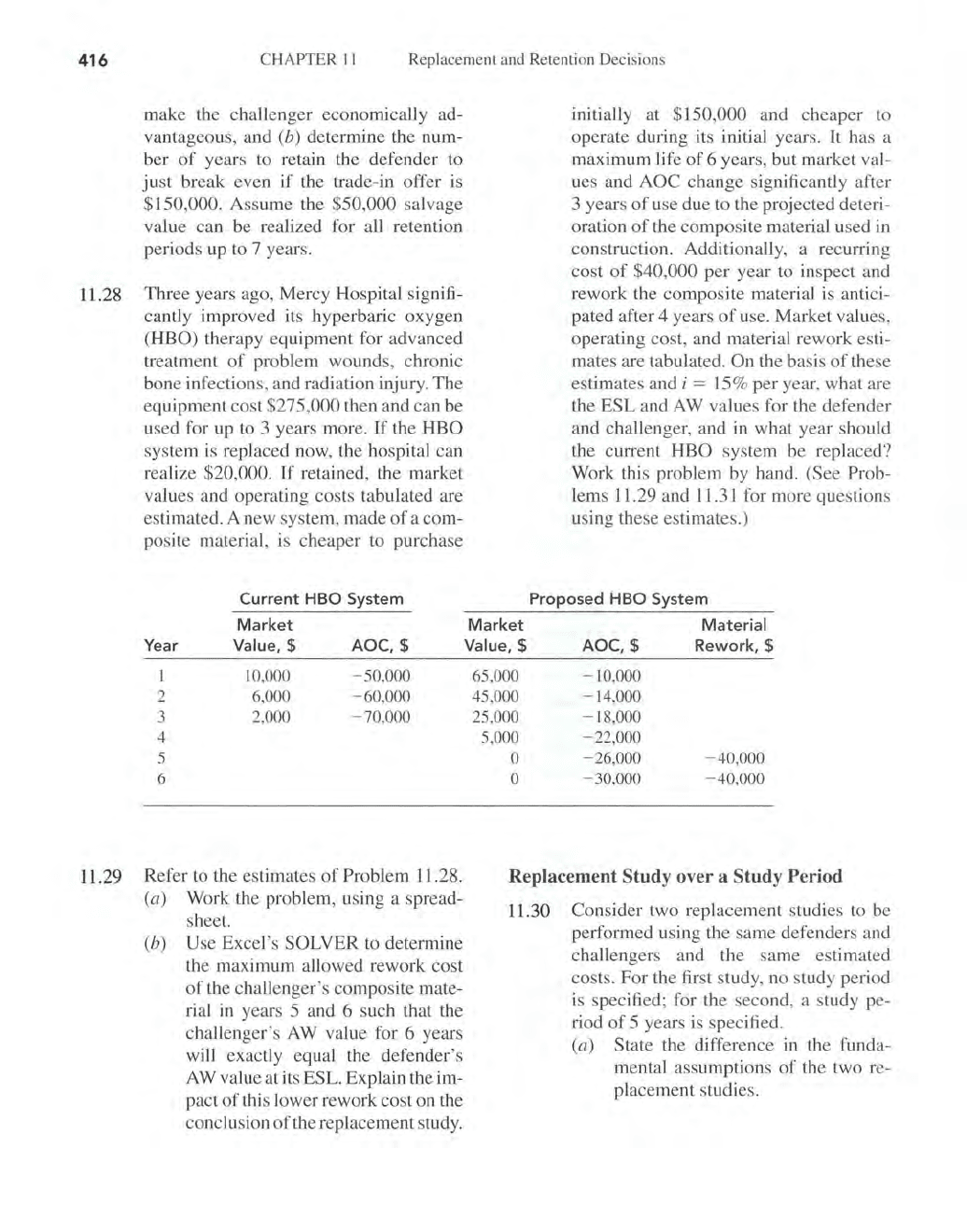
416
CHAPTER
II
Replacement and Retention Decisions
make the challenger economically ad-
vantageous, and
(b)
determine the num-
ber
of
years to retain the defender to
just
break even
if
the trade-in offer is
$150,000. Assume the $50,000 salvage
value can be realized for all retention
periods up
to
7 years.
11.28 Three years ago, Mercy Hospital signifi-
cantly improved its hyperbaric oxygen
(HBO) therapy equipment for advanced
treatment
of
problem wounds, chronic
bone infections, and radiation injury. The
equipment cost $275,000 then and can be
used for up to 3 years more.
If
the HBO
system
is
replaced now, the hospital can
realize $20,000.
If
retained, the market
values and operating costs tabulated are
estimated. A new system, made
of
a com-
posite material,
is
cheaper to purchase
Current
HBO
System
Market
Year
Value, $
AOC,
$
I
10
,000
- 50,000
2 6,000
- 60,000
3 2,000
- 70,000
4
5
6
11.29 Refer to the estimates
of
Problem]]
.28.
(a) Work the problem, using a spread-
sheet.
(b) Use Excel's SOLVER
to
determine
the maximum allowed rework cost
of
the challenger's composite mate-
rial in years 5 and 6 such that the
challenger's
AW
value for 6 years
will exactly equal the defender's
A W value at its
ESL. Explain the im-
pact
of
this lower rework cost on the
conclusion
of
the replacement study.
Market
Value, $
65
,000
45
,000
25
,000
5,000
0
0
initially at $150,000 and cheaper
to
operate during its initial years. It has a
maximum life
of
6 years, but market val-
ues and
AOC change significantly after
3 years
of
use due to the projected deteri-
oration
of
the composite material used
in
construction. Additionally, a recurring
cost
of
$40,000 per year to inspect and
rework the composite material is antici-
pated after 4 years
of
use. Market values,
operating cost, and material rework esti-
mates are tabulated.
On the basis
of
these
estimates and
i =
15
% per year, what are
the
ESL
and A W values for the defender
and challenger, and
in
what year should
the current
HBO system be replaced?
Work this problem
by
hand. (See Prob-
lems
1l.29
and 11.31 for more questions
using these estimates.)
Proposed
HBO
System
AOC,$
-
10
,000
- 14,000
-
18
,000
-
22
,000
-
26
,000
- 30,000
Material
Rework,
$
- 40,000
- 40,000
Replacement Study over a Study Period
11.30 Consider two replacement studies to be
performed using the same defenders and
challengers and the same estimated
costs. For the first study, no study period
is specified; for the second, a study pe-
riod
of
5 years is specified.
(a) State the difference
in
the funda-
mental assumptions
of
the two re-
placement studies.

(b) Describe the differences
in
the
procedures followed
in
performing
the replacement studies for the
conditions.
11
.31
Reread the situation and estimates ex-
plained
in
Problem 11.28. (a) Perform
the replacement study for a fixed study
period
of
5 years.
(b)
If
,
in
lieu
of
the
challenger purchase, a full-service con-
tract for hyperbaric oxygen therapy were
offered
to
Mercy Hospital for a total
of
$85,000 per year
if
contracted for 4
or
5 years or $100,000 for a 3-year or less
contract, which option or combination is
economically the best between the de-
fender and the contract?
11.32
An
in-place machine has
an
equivalent
annual worth
of
$-200
,000 for each
year
of
its maximum remaining useful
life
of
2 years. A suitable replacement is
determined to have equivalent annual
worth values
of
$- 300,000, $- 225,000,
and $- 275,000 per year, if kept for 1, 2,
or 3 years, respectively. When should the
company replace the machine, if it uses a
fixed 3-year planning horizon?
Use an
interest rate
of
18
% per year.
11.33
Use a spreadsheet to perform a replace-
ment analysis for the following situa-
tion.
An
engineer estimates that the
equivalent annual worth
of
an existing
machine over its remaining useful life
of
3 years
is
$-90,000
per year.
It
can be
replaced now or after 3 years with a ma-
chine that will have
an
AW
of
$-90,000
per year if kept for 5 years or less
and $ -
110
,000 per year if kept for 6 to
8 years.
(a)
Perform the analysis to determine
the
AW
values for study periods
of
length 5 through 8 years at an inter-
est rate
of
10% per year. Select the
study period with the lowest AW
PROBLEMS
417
value. How many years are the de-
fender and challenger used?
(b)
Can the
PW
values be used to se-
lect the best study period length
and decide to retain or replace the
defender? Why or why not?
11.34 Nabisco Bakers currently employs staff
to operate the equipment used to steril-
ize much
of
the mixing, baking, and
packaging facilities in a large cookie
and cracker manufacturing plant in
Iowa. The plant manager, who
is
dedi-
cated to cutting costs but not sacrificing
quality and cleanliness, has the pro-
jected data were the current system re-
tained for up to its maximum expected
life
of
5 years. A contract company has
proposed a turnkey sanitation system
for
$5.0 million per year
if
Nabisco
signs on for 4 to
10 years and $5.5 mil-
lion per year for a smaller number
of
years.
(a) At an MARR = 8% per year, per-
form a replacement study for the
plant manager with a fixed plan-
ning horizon
of
5 years, when it
is
anticipated that the plant will be
shut down due to age
of
the facility
and projected technological obso-
lescence. As you perform the study,
take into account the fact that re-
gardless
of
the number
of
years that
the current sanitation system
is
re-
tained, a one-time close-down cost
will be incurred for personnel and
equipment during the last year
of
operation.
(b)
What is the percentage change in
AW
amount each year
of
the 5-year
study period?
If
the decision to re-
tain the current sanitation system is
made, what is the economic disad-
vantage in A W amount compared
to that
of
the best economic reten-
tion period?
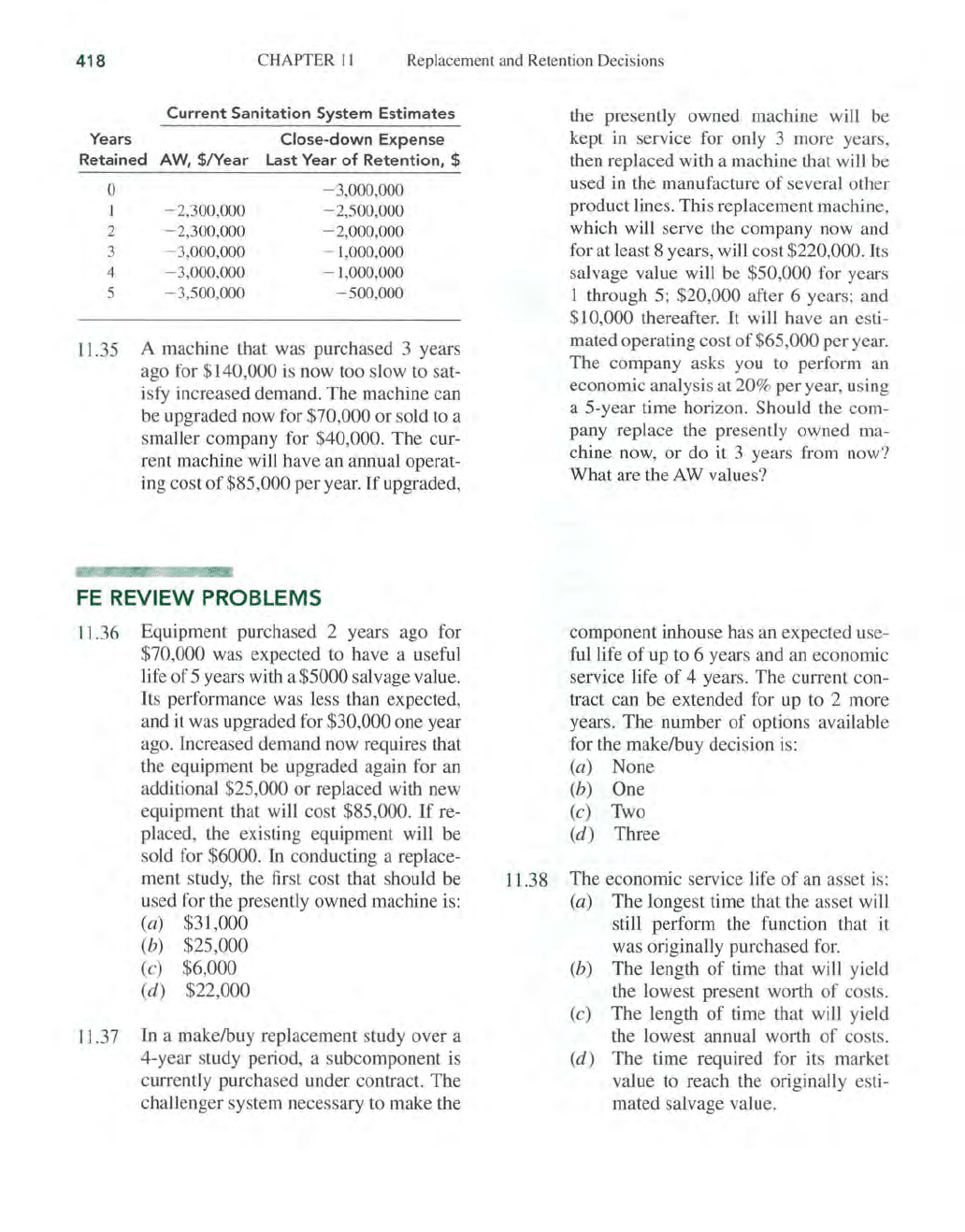
418
CHAPTER
II
Replacement and Retention Decisions
Current
Sanitation
System
Estimates
Years
Close-down
Expense
Retained
AW,
$lYear
Last Year
of
Retention,
$
0 - 3,000,000
- 2,300,000
- 2,500,000
2 - 2,300,000
- 2,000,000
3 - 3,000,000
- 1,000,000
4 - 3,000,000 - 1,000,000
5 - 3,500,000 - 500,000
1l.35 A machine that was purchased 3 years
ago for
$140
,
000
is now too slow to sat-
isfy increased demand.
The
machine can
be upgraded now for
$70,000
or
sold to a
smaller company for
$40,000. The cur-
rent machine will have an annual operat-
ing cost
of
$85,000 per year.
If
upgraded,
FE
REVIEW PROBLEMS
11.36 Equipment purchased 2 years ago for
$70,000 was expected to have a useful
life
of
5 years with a $5000 salvage value.
Its performance was less than expected,
and it was upgraded for
$30,000 one year
ago. Increased demand now requires that
the equipment be upgraded again for an
additional
$25,000
or
replaced with new
equipment that will cost
$85,000.
If
re-
placed, the existing equipment will be
sold for
$6000. In conducting a replace-
ment study, the first cost that should be
used for the presently owned machine is:
(a) $31,000
(b) $25,000
(c) $6,000
(d)
$22,000
11.37 In a makelbuy replacement study over a
4-year study period, a subcomponent is
currently purchased under contract.
The
challenger system necessary to make the
the presently owned machine will be
kept in service for only 3 more years,
then replaced with a machine that will be
used
in
the manufacture
of
several other
product lines. This replacement machine,
which will serve the company now and
for at least 8 years, will cost
$220,000. Its
salvage value will be
$50,000 for years
1 through 5;
$20,
000
after 6 years; and
$10,000 thereafter. It will have an esti-
mated operating cost
of
$65,
000
per ye
ar.
The
company asks you to perform
an
economic analysis at
20
%
per
year, using
a 5-year time horizon. Should the com-
pany replace the presently owned ma-
chine now,
or
do it 3 years from now?
What
are the A W val ues?
component inhouse has an expected use-
fullife
of
up to 6 years and an economic
service life
of
4 years.
The
current con-
tract can be extended for up to 2 more
years.
The
number
of
options available
for the makelbuy decision is:
(a) None
(b)
One
(c) Two
(d)
Three
11.38
The
economic service life
of
an asset is:
(a) The longest time that the asset will
still perform the function that it
was originally purchased for.
(b)
The
length
of
time that will yield
the lowest present worth
of
costs.
(c)
The
length
of
time that will yield
the lowest annual worth
of
costs.
(d)
The
time required for its market
value to reach the originally es
ti
-
mated salvage value.

EXTENDED EXERCISE
419
11
.39 In a replacement study conducted last
year, it was determined that the de-
fender should be kept for
3 more years.
Now, however, it
is
clear that some
of
the estimates made last year for this
year and next year have changed sub-
stantially. The proper course
of
action
is
to:
11.40
The
AW values calculated for a retain-
or-replace decision with no stated study
period are
as
shown.
(a) Replace the existing asset now.
Ye
ar
2
3
4
AWto
Replace, $lYear
-25,500
-25,500
- 26,900
-27,000
AWto
Retain, $lYear
- 27,000
-
26
,500
- 25,000
- 25,900
(b) Replace the existing asset 2 years
from now, as was determined last
year.
(c) Conduct a new replacement study
using the new estimates.
The
defender should be replaced:
(a) After 4 more years.
(b) After 3 more years.
(d)
Conduct a new replacement study
using last year's estimates.
(c) After 1 more year.
(d)
Now
EXTENDED EXERCISE
ECONOMIC SERVICE LIFE UNDER VARYING CONDITIONS
New pumper system equipment
is
under consideration by a Gulf Coast chemical
processing plant. One crucial pump moves highly corrosive liquids from specially
lined tanks on intercoastal barges into storage and
prelirllinary refining facilities
dockside. Because
of
the variable quality
of
the raw chemical and the high pres-
sures imposed on the pump chassis and impellers, a close log is
maintained on the
number
of
hours per year that the pump operates. Safety records and pump com-
ponent deterioration are considered critical control points for this system. As cur-
rently planned, rebuild and
M&O
cost estimates are increased accordingly when
cumulative operating time reaches the
6000-hour mark. Estimates made for this
pump are
as
follows:
First cost:
Rebuild cost:
M&O
costs:
MARR:
$-800,000
$-150,000
whenever 6000 cumulative hours are logged.
Each rework will cost
20% more than the previous one. A
maximum
of
3 rebuilds
is
allowed.
$25,000 for each year 1 through 4
$40,000 per year starting the year after the first rebuild, plus
15
% per year thereafter
10% per year
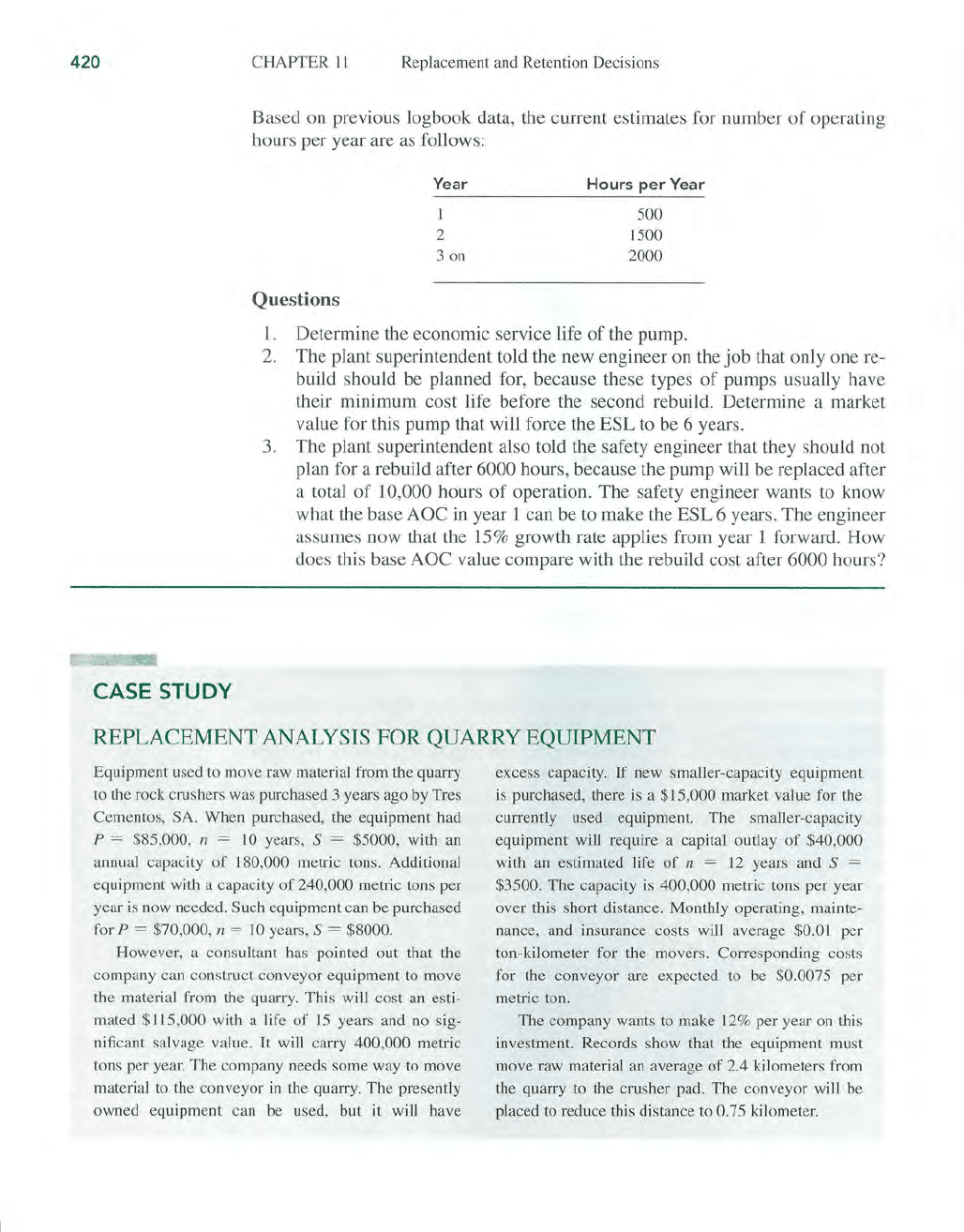
420
CHAPTER
II
Replacement and Retention Decisions
Based on previous logbook data, the current estimates for number
of
operating
hours per year are
as
follows:
Questions
Year
1
2
3
on
Hours
per
Year
500
1500
2000
I.
Determine the economic service life
of
the pump.
2.
The plant superintendent told the new engineer on the job that only one re-
build should be planned for, because these types
of
pumps usually have
their minimum cost life before the second rebuild. Determine a market
value for this pump that will force the ESL to be 6 years.
3.
The plant superintendent also told the safety engineer that they should not
plan for a rebuild after
6000 hours, because the pump will be replaced after
a total
of
10,000 hours
of
operation. The safety engineer wants
to
know
what the base
AOe
in
year 1 can be to make the ESL 6 years. The engineer
assumes now that the 15% growth rate applies from year 1 forward. How
does this base
AOe
value compare with the rebuild cost after 6000 hours?
CASE
STUDY
REPLACEMENT ANALYSIS
FOR
QUARRY EQUIPMENT
Equipment used to move raw material from the quarry
to
the rock crushers was purchased 3 years ago by Tres
Cementos, SA. When purchased, the equipment had
P = $85,000, n =
10
years, S = $5000, with
an
annual capacity
of
180,000 metric tons. Additional
equipment with a capacity
of
240,000 metric tons per
year
is
now needed. Such equipment can be purchased
for
P = $70,000, n = 10 years, S = $8000.
However, a consultant has pointed out that the
company can construct conveyor equipment to move
the material from the quarry. This will cost an esti-
mated
$115,000 with a life
of
15
years and
no
sig-
nificant salvage value.
It
will carry 400,000 metric
tons per year. The company needs some way to move
material
to
the conveyor
in
tbe quarry. The presently
owned equipment can
be
used, but .it will have
excess capacity. If new smaller-capacity equipment
is purchased, there is a
$15,000 market value for the
currently used equipment. The smaller-capacity
equipment will require a capital outlay
of
$40,000
with
an
estimated life
of
n =
12
years and S =
$3500. The capacity is 400,000 metric tons per year
over this short distance. Monthly operating, mainte-
nance, and insurance costs will average
$0.01 per
ton-kilometer for the movers. Corresponding costs
for the conveyor are expected to be
$0.0075 per
metric ton.
The company wants to make 12% per year
on
this
investment. Records show that the equipment must
move raw material
an
average
of
2.4 kilometers from
the quarry to the crusher pad. The conveyor will be
placed to reduce this distance to
0.75 kilometer.
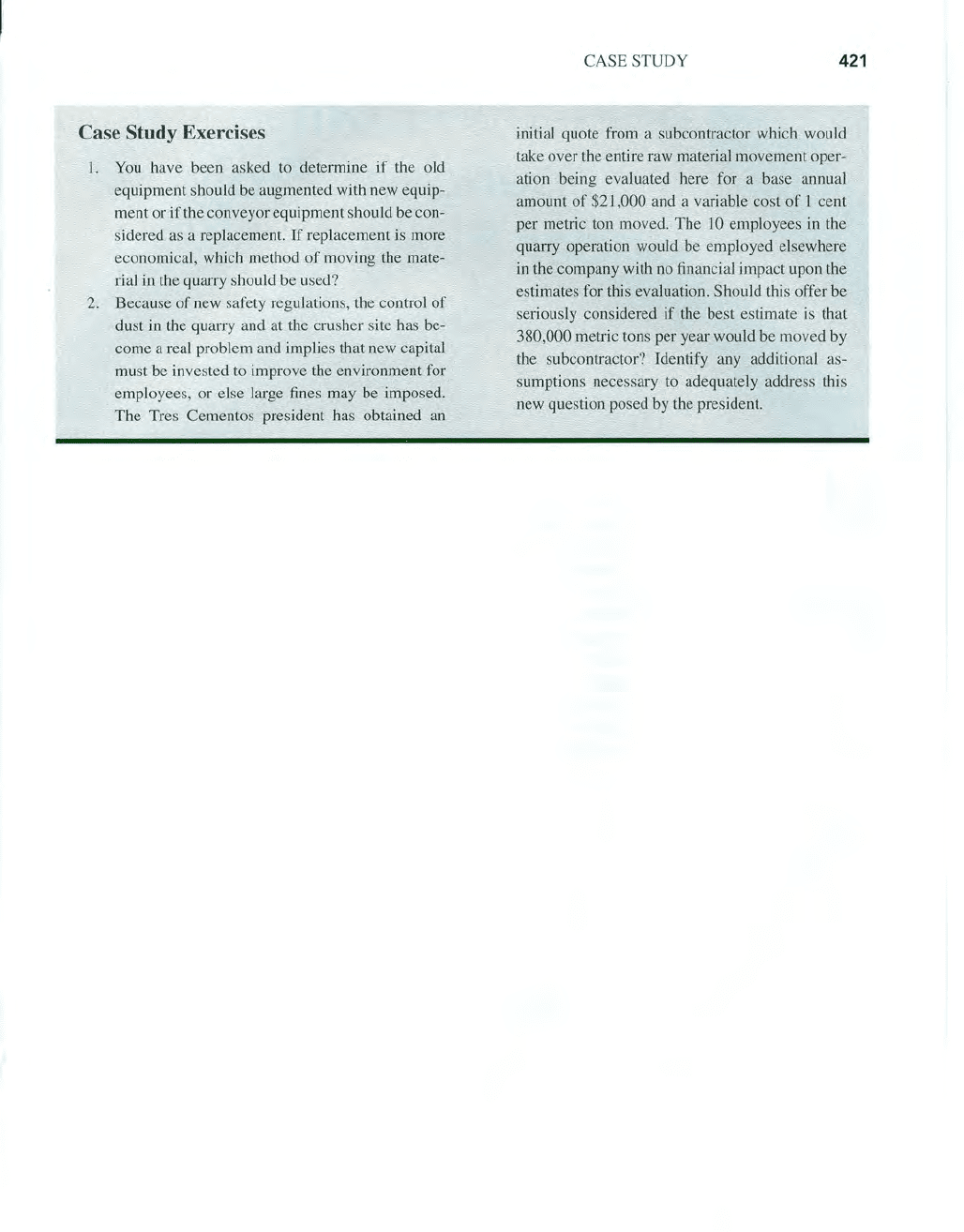
Case Study Exercises
1.
You
have been asked to determine
if
the old
equipment should be augmented with new
equip-
ment
or
if the conveyor equipment should be con-
sidered
as
a
rep
lacement.
If
replacement is more
economical, which method
of
moving the mate-
rial in the quarry should be used?
2. Because
of
new safety regulations, the control
of
dust in the quarry and at the crusher site has be-
come a real problem and implies that new capital
must be invested to improve the environment for
employees,
or
else large fines may be imposed.
The Tres Cementos president has obtained
an
CASE STUDY
421
initial quote from a subcontractor which would
take over the entire raw material movement oper-
ation being evaluated here for a base annual
amount
of
$21,000 and a variable cost
of
1 cent
per metric ton moved. The
10 employees
in
the
quarry operation would be employed elsewhere
in the company with no financial impact upon the
estimates for this evaluation. Should this offer be
seriously considered
if
the best estimate is that
380,000 metric tons per year would be moved by
the subcontractor? Identify any additional as-
sumptions necessary to adequately address this
new question posed by the president.
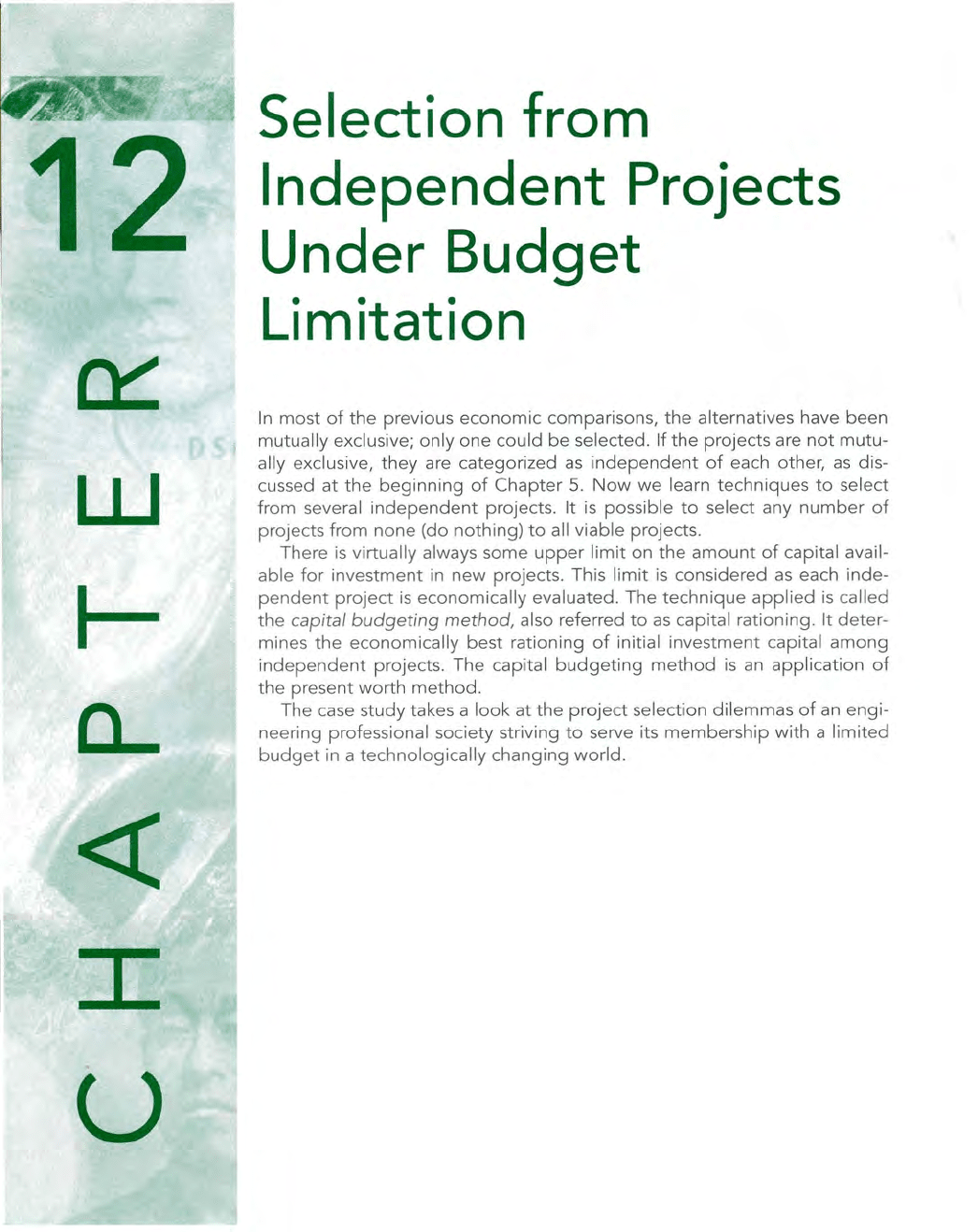
UJ
I-
I
u
Selection from
Independent
Projects
Under
Budget
Limitation
In
most
of
the
previous
economic
comparisons,
the
alternatives have
been
mutually
exclusive;
only
one
could
be
selected. If
the
projects
are
not
mutu-
ally exclusive,
they
are
categorized
as
independent
of
each other,
as
dis-
cussed at
the
beginning
of
Chapter
5.
Now
we
learn
techniques
to
select
from
several
independent
projects. It
is
possible
to
select any
number
of
projects
from
none
(do
nothing)
to
all
viable
projects
.
There
is
virtually
always
some
upper
limit
on
the
amount
of
capital avail-
able
for
investment
in
new
projects
. This
limit
is
considered
as
each
inde-
pendent
project
is
economically
evaluated.
The
technique
applied
is
called
the
capital
budgeting
method,
also referred
to
as
capital
rationing.
It
deter-
mines
the
econom
ically
best
rationing
of
initial
investment
capital
among
independent
projects. The capital
budgeting
method
is
an
application
of
the
present
worth
method.
The case
study
takes a
look
at
the
project
selection
dilemmas
of
an
engi-
neering
professional society striving
to
serve its
membership
with
a
limited
budget
in a
technologically
changing
world
.
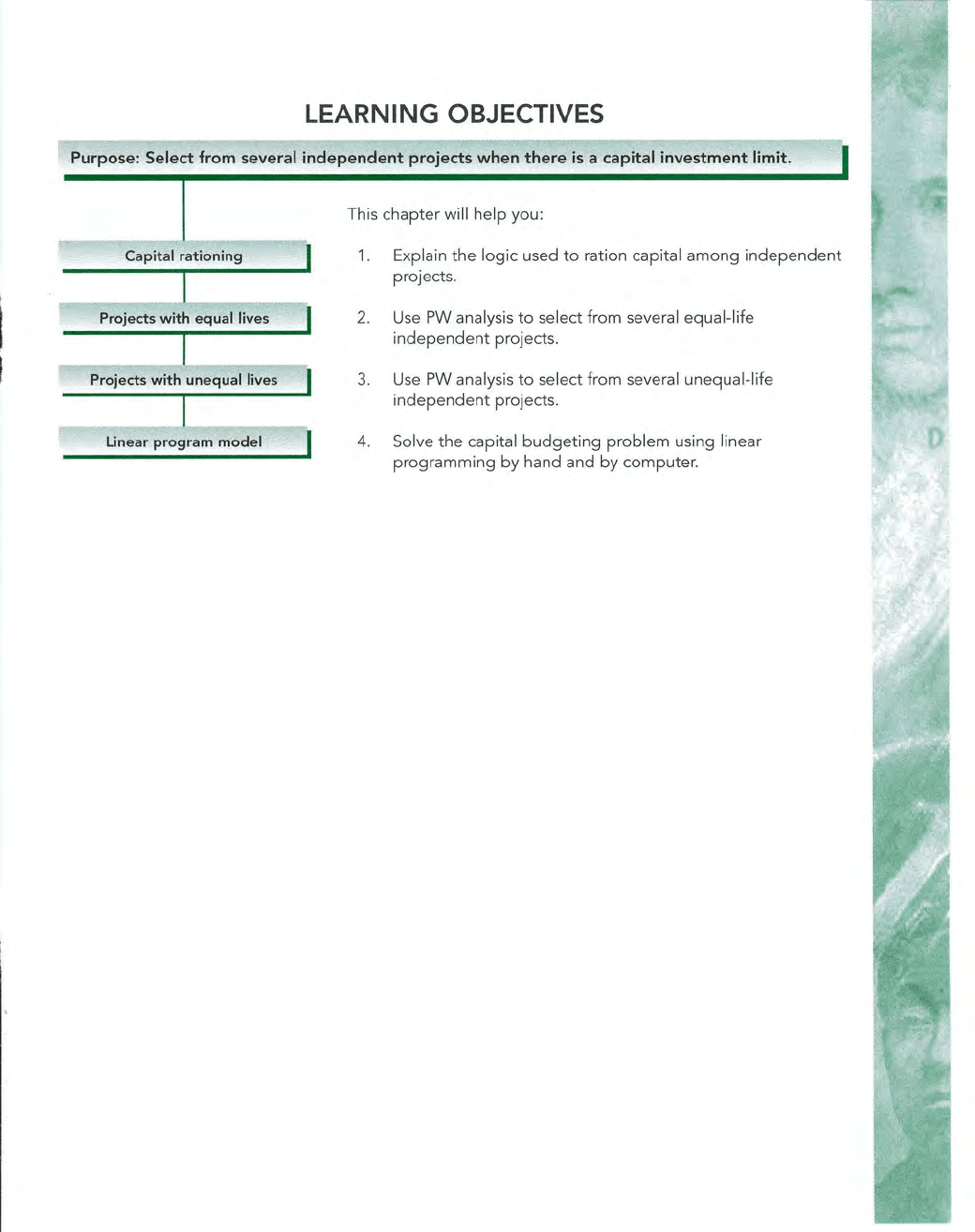
LEARNING OBJECTIVES
Purpose: Select from several independent projects when there
is
a capital investment limit.
Capital rationing
Projects with equal lives
Projects with unequal lives
Linear program model
This
chapter
will
help
you:
1.
Explain
the
logic
used
to
ration capital
among
independent
projects.
2. Use PW analysis
to
select
from
several equal-life
independent
projects.
3. Use PW analysis
to
select from several unequal-life
independent
projects.
4.
Solve
the
capital
budgeting
problem
using linear
programming
by
hand and
by
computer
.
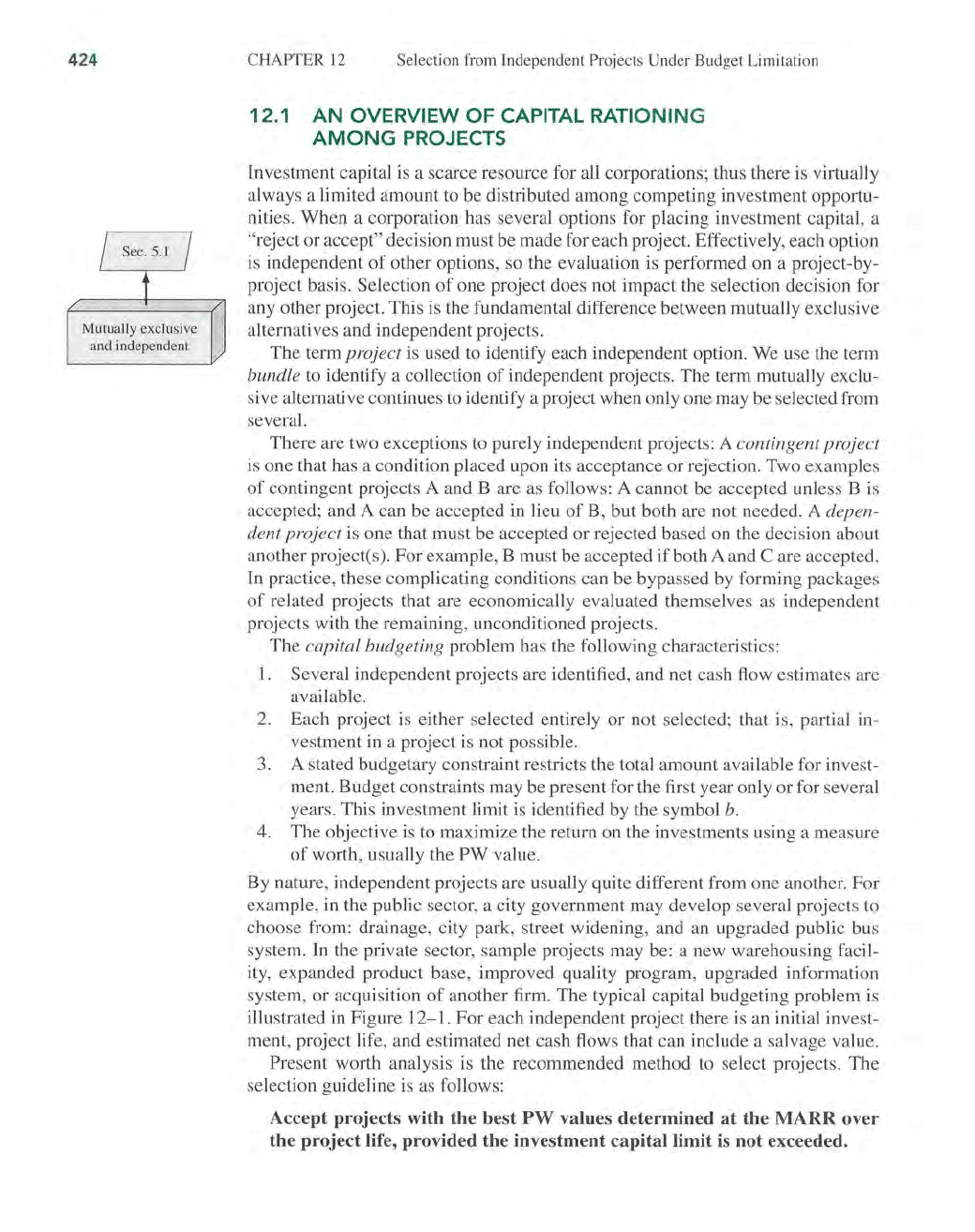
424
I Sec.
5.1
I
t
Mutually exclusive
and independent
L-
_____
-l-'V
CHAPTER
12 Selection from Independent Projects Under Budget Limitation
12.1
AN
OVERVIEW OF CAPITAL RATIONING
AMONG
PROJECTS
Investment capital is a scarce resource for all corporations; thus there is virtually
always a limited amount
to
be distributed among competing investment opportu-
nities. When a corporation has several options for placing investment capital, a
"reject or accept" decision must be made for each project. Effectively, each option
is independent
of
other options, so the evaluation is performed on a project-by-
project basis. Selection
of
one project does not impact the selection decision for
any other project. This is the fundamental difference between mutually exclusive
alternatives and independent projects.
The term
project is used
to
identify each independent option.
We
use the term
bundle
to
identify a collection of independent projects. The term mutually exclu-
sive alternative continues
to
identify a project when only one may be selected from
several.
There are two exceptions to purely independent projects: A
contingent project
is
one that has a condition placed upon its acceptance or rejection. Two examples
of
contingent projects A and B are
as
follows: A cannot be accepted unless B is
accepted; and A can be accepted in lieu
of
B, but both are not needed. A depen-
dent project
is one that must be accepted or rejected based on the decision about
another project(s). For example, B must be accepted
if
both A and C are accepted.
In
practice, these complicating conditions can be bypassed
by
forming packages
of
related projects that are economically evaluated themselves
as
independent
projects with the remaining, unconditioned projects.
The
capital budgeting problem has the following characteristics:
1.
Several independent projects are identified, and net cash flow estimates are
available.
2.
Each project is either selected entirely or not selected; that is, partial in-
vestment
in
a project
is
not possible.
3.
A stated budgetary constraint restricts the total amount available for invest-
ment. Budget constraints may be present for the first year only or for several
years. This investment limit
is
identified by the symbol
b.
4.
The objective is to maximize the return on the investments using a measure
of
worth, usually the PW value.
By nature, independent projects are usually quite different from one another. For
example, in the public sector, a city government may develop several projects
to
choose from: drainage, city park, street widening, and an upgraded public bus
system. In the private sector, sample projects may be: a new warehousing facil-
ity, expanded product base, improved quality program, upgraded information
system, or acquisition
of
another firm. The typical capital budgeting problem
is
illustrated
in
Figure 12-1. For each independent project there
is
an initial invest-
ment, project life, and estimated net cash flows that can include a salvage value.
Present worth analysis is the recommended method
to
select projects. The
selection guideline
is
as
follows:
Accept projects with the best
PW
values
determined
at
the
MARR
over
the project life, provided the investment capital limit is
not
exceeded.
